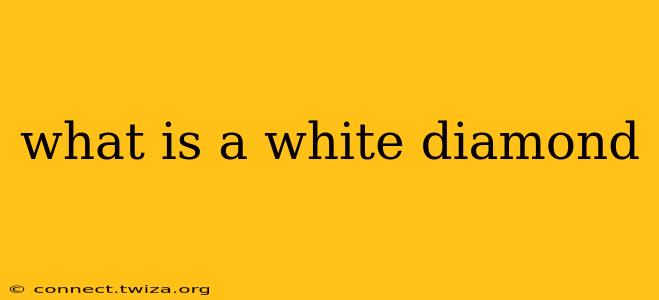White diamonds, often simply called "diamonds," are the most popular and widely known type of diamond. Their captivating brilliance and inherent rarity make them highly sought-after gemstones, coveted for engagement rings, necklaces, and other luxury jewelry. But what truly defines a white diamond, and what factors influence its value? Let's delve into the details.
What Makes a Diamond "White"?
The term "white diamond" is a bit of a misnomer. True colorless diamonds are exceptionally rare. Most diamonds exhibit some degree of color, albeit often very subtle. The whiteness we perceive is actually the absence of noticeable color. These diamonds are graded on a color scale, ranging from D (completely colorless) to Z (light yellow or brown). Diamonds graded D-F are considered colorless, while those graded G-J are near-colorless. The lower the letter in the grading scale, the rarer and more valuable the diamond.
What are the Characteristics of a White Diamond?
Several characteristics determine the overall quality and value of a white diamond:
-
Color: As discussed, the color grading scale (D-Z) is a crucial factor. Colorless diamonds are the most prized.
-
Clarity: This refers to the presence of internal inclusions (flaws within the diamond) and external blemishes (imperfections on the surface). Diamonds with fewer inclusions and blemishes command higher prices. Clarity grades range from Flawless (FL) to Included (I3).
-
Cut: The cut refers to how well a diamond's facets interact with light. An excellent cut maximizes brilliance, fire (dispersion of color), and scintillation (sparkle). Cut grading is often described as Excellent, Very Good, Good, Fair, or Poor.
-
Carat Weight: This refers to the diamond's weight, with one carat equaling 200 milligrams. Larger diamonds are generally more expensive, but the price per carat can vary significantly depending on the other factors (color, clarity, and cut).
How are White Diamonds Formed?
White diamonds are formed deep within the Earth's mantle under immense pressure and heat. They are brought to the surface through volcanic eruptions and are mined from various locations around the globe. The process takes billions of years, making them a truly remarkable natural wonder.
What is the Difference Between White Diamonds and Other Colored Diamonds?
While white diamonds are prized for their lack of color, other colored diamonds, like fancy yellow, pink, or blue diamonds, are highly sought-after for their intense hues. These colored diamonds owe their color to trace elements present during their formation, making them even rarer and more valuable than the most colorless white diamonds.
What are the different types of white diamonds?
There isn't a strict categorization of "types" of white diamonds beyond the grading system based on the 4 Cs (Color, Clarity, Cut, Carat). However, diamonds can be sourced from different mines, leading to slight variations in their characteristics. Some might have slightly different fluorescence (the way they react to ultraviolet light), which can subtly affect their appearance.
How Much Do White Diamonds Cost?
The cost of a white diamond is highly variable and depends on the interplay of the four Cs. A larger, flawless, and perfectly cut diamond will command a significantly higher price than a smaller, less-ideal diamond. Pricing can range from a few hundred dollars to millions of dollars depending on these factors.
How Can I Tell if a White Diamond is Real?
Determining the authenticity of a diamond requires expertise. Reputable jewelers employ various tests, including using magnification to inspect inclusions, checking refractive index, and sometimes employing more sophisticated equipment. Purchasing diamonds from trusted sources is crucial to ensure authenticity.
This comprehensive guide should provide a clear understanding of white diamonds. Remember, consulting a qualified gemologist is always recommended before making a significant diamond purchase.
